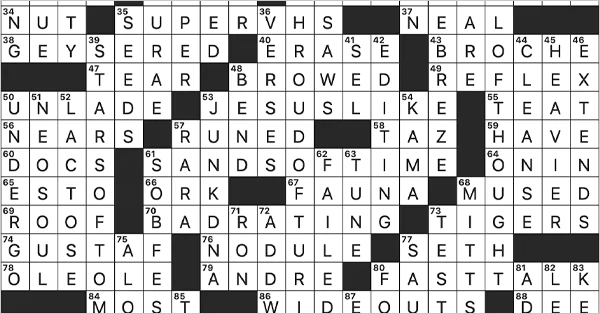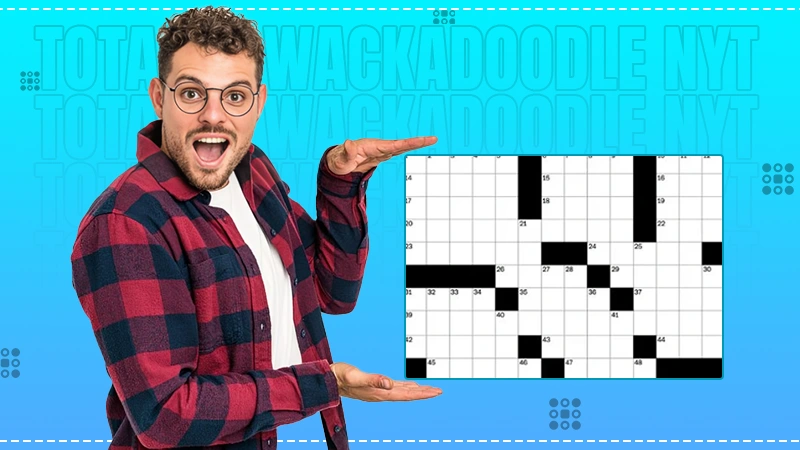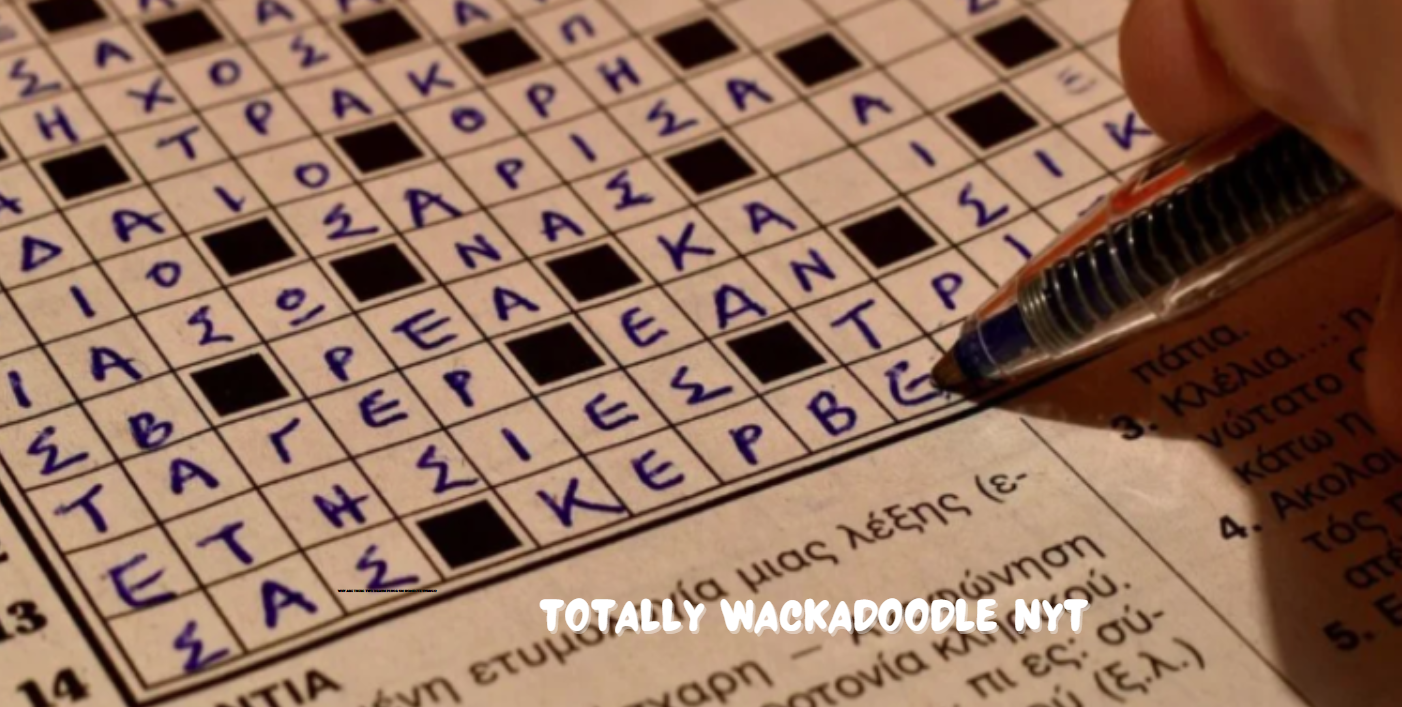Totally Wackadoodle NYT: Unraveling the Popular Crossword Puzzle Clue
Crossword puzzles are a cherished pastime in the United States, and few puzzle sources are as iconic as those published in The New York Times. Known for their clever wordplay and challenging clues, the NYT crossword puzzles draw enthusiasts from all walks of life.
One clue that has captured the attention of many solvers is “totally wackadoodle,” a playful and quirky hint that has sparked curiosity and conversation across crossword circles.
In this comprehensive guide, we’ll delve into the meaning behind the clue “totally wackadoodle nyt,” examine its context, analyze the intricacies of crossword puzzle design, and provide unique insights that go beyond what’s already available online.
We’ll also explore the cultural relevance of terms like “wackadoodle” and how they fit into modern language trends. By the end of this article, you’ll have a thorough understanding of not only the “totally wackadoodle” clue but also the broader context of how crossword puzzles engage and challenge our minds.

Also Read: Tanxohub: Revolutionizing Business Growth and EfficiencyTanxohub
Introduction to Totally Wackadoodle NYT
The phrase “totally wackadoodle” first gained prominence in The New York Times crossword puzzle, catching the attention of many solvers due to its unusual and humorous nature. The clue “totally wackadoodle“ led solvers to the word “inane”, sparking discussions about the term’s meaning and how it relates to the solution.
Crossword puzzle clues often play on double meanings, synonyms, and cultural references, making them more than simple word-matching exercises. In this case, the use of “wackadoodle” as a clue adds an extra layer of entertainment and challenge for solvers, encapsulating the essence of crossword design, where language, humor, and wit intersect.
In this article, we’ll not only decode the clue but also explore the linguistic and cultural dimensions of terms like “wackadoodle” and how they enrich the experience of solving puzzles.
What Does “Totally Wackadoodle” Mean?
To understand why “totally wackadoodle” was used in the NYT crossword, we need to break down the meaning of the word “wackadoodle.”
Definition of Wackadoodle
The term wackadoodle is often used informally to describe someone or something that is eccentric, fanatical, or a little offbeat. It’s a lighthearted way to call out odd or peculiar behavior without being overly critical. The word “wackadoodle” is likely derived from “wacky,” a term that gained popularity in the 20th century to describe something silly or crazy.
In modern usage, wackadoodle typically refers to something or someone that is strange or nonsensical, often in a whimsical or humorous way. It’s not meant to be offensive but rather to describe something amusingly outlandish.
“Totally Wackadoodle”
When paired with the word “totally”, as it was in the NYT crossword, the phrase intensifies the meaning. “Totally wackadoodle” can be interpreted as something that is completely nonsensical, absurd, or over-the-top ridiculous. It’s a colorful way of describing extreme eccentricity or lack of logic.
Given this meaning, it’s easy to see why the answer to the clue “totally wackadoodle” in the NYT crossword was “inane.” Inane refers to something silly or meaningless—precisely the essence of the phrase “totally wackadoodle.”

Also Read: Tanxohub: Revolutionizing Business Growth and EfficiencyTanxohub
Crossword Puzzle Clue: Decoding “Totally Wackadoodle”
In the world of crossword puzzles, clues are often designed to make solvers think creatively and stretch their vocabulary. The “totally wackadoodle nyt” clue was no different, designed to challenge players with its quirky and colloquial phrasing.
Why “Inane” as the Answer?
The answer “inane” fits perfectly because it captures the essence of something that is devoid of meaning or sense—qualities that are inherent in the phrase “totally wackadoodle.”
- Inane: Silly or senseless.
- Wackadoodle: Crazy or nonsensical.
By using the word “totally,” the clue pushes the solver to think of an exaggerated level of absurdity, ultimately leading to “inane.” This kind of playful clue is a hallmark of The New York Times crossword, where puns, wordplay, and unexpected connections keep solvers engaged.
Crossword Clue Design
The clue “totally wackadoodle” is an example of how crossword creators blend modern slang with traditional puzzle-making techniques. Here, the clue taps into casual, conversational language to point to a word that’s more formal in meaning. This contrast makes the puzzle both fun and educational, as solvers must bridge the gap between the colloquial and the academic.
The Art of NYT Crossword Puzzle Creation
Creating a crossword puzzle is no easy feat. It requires a deep understanding of language, wordplay, and how to challenge solvers without making the puzzle too obscure or frustrating. Will Shortz, the long-time editor of The New York Times crossword, has perfected this balance, curating puzzles that are both intellectually stimulating and highly entertaining.
Key Elements of a Great NYT Crossword Puzzle:
- Clever Clueing: The clues in the NYT crossword are designed to be ambiguous, yet solvable. They often have multiple meanings or require a bit of lateral thinking to arrive at the correct answer.
- Cultural References: The NYT crossword frequently draws on current events, pop culture, and modern slang—like “totally wackadoodle”—to make the puzzles relatable to today’s audience.
- Wordplay: Puns, homophones, and other forms of wordplay are integral to the NYT crossword experience. Clues like “totally wackadoodle” exemplify how playful language can be used to create a challenging and enjoyable puzzle.
The success of the NYT crossword lies in its ability to keep solvers on their toes, mixing highbrow language with accessible, everyday terms in a way that appeals to a broad audience.
Also Read: Tanxohub: Revolutionizing Business Growth and EfficiencyTanxohub
How “Totally Wackadoodle” Fits Into Language Trends
The Evolution of Slang
Language is constantly evolving, and slang terms like “wackadoodle” are a testament to how words can shift in meaning and usage over time. While wackadoodle may have originated as a quirky way to describe someone eccentric, its usage has expanded to include anything that is absurd, nonsensical, or over-the-top.
Slang often makes its way into crossword puzzles, particularly as younger generations engage with the medium. The NYT crossword’s use of phrases like “totally wackadoodle” reflects how the puzzle adapts to modern language trends, ensuring its continued relevance in today’s fast-paced, ever-changing linguistic landscape.
Why The NYT Crossword is Iconic in the USA
The New York Times crossword puzzle is widely regarded as one of the best in the world. It has a storied history, dating back to the early 20th century, and has become a daily ritual for millions of Americans.
Key Reasons for Its Popularity:
- Prestige: Solving the NYT crossword, especially the more difficult Saturday puzzle, is a badge of honor among crossword enthusiasts. It’s seen as a test of one’s intellectual mettle.
- Wide Appeal: The puzzle appeals to people of all ages and backgrounds. Its clues range from pop culture references to historical facts, meaning there’s something for everyone.
- Challenge: The NYT crossword is known for being tough but fair. It pushes solvers to think creatively and stretch their vocabulary.
The clue “totally wackadoodle” is a great example of how the NYT crossword can be both accessible and challenging at the same time, drawing on modern language while still requiring a deep understanding of words and meanings.
The Popularity of Crossword Puzzles in American Culture
Crossword puzzles are deeply ingrained in American culture. From casual solvers to dedicated “cruciverbalists” (a fancy term for crossword enthusiasts), millions of people turn to puzzles as a way to pass time, challenge their brains, and have fun.
Why Do Americans Love Crosswords?
- Mental Stimulation: Crossword puzzles engage multiple areas of the brain, improving cognitive function and keeping the mind sharp.
- Stress Relief: Solving a puzzle can be a great way to unwind and take a break from the stresses of daily life.
- Sense of Accomplishment: Completing a tough puzzle, like the NYT Saturday crossword, gives solvers a real sense of achievement.
The quirky clues in the NYT crossword, such as “totally wackadoodle,” add an element of surprise and joy to the solving experience, making the puzzle more than just a word game—it’s a form of entertainment.
How to Approach Quirky Clues Like “Totally Wackadoodle”
Solving quirky clues like “totally wackadoodle” can be tricky, especially if you’re not familiar with slang or colloquial terms. Here are some tips to help you approach these types of clues with confidence.
Think Outside the Box
Clues like “totally wackadoodle” often require lateral thinking. Don’t take the words at face value—consider alternative meanings or associations.
Consider the Length of the Answer
The number of letters in the answer can often provide helpful context. In this case, the answer “inane” fits neatly into a five-letter space, which may help narrow down your options.
Look for Synonyms
Words like “wackadoodle” may have more formal synonyms, like “inane” or “absurd.” If a clue seems too playful, try thinking of a more straightforward word that conveys the same meaning.

Also Read: Tanxohub: Revolutionizing Business Growth and EfficiencyTanxohub
The Psychological Benefits of Crossword Puzzles
Solving crossword puzzles isn’t just a fun pastime—it’s also great for your brain. Numerous studies have shown that regular puzzle-solving can improve memory, cognitive function, and even stave off age-related cognitive decline.
Key Benefits:
- Improved Vocabulary: Crossword puzzles introduce solvers to new words and meanings, expanding their vocabulary.
- Enhanced Problem-Solving Skills: Puzzles require critical thinking and pattern recognition, skills that are valuable in many areas of life.
- Memory Boost: Solving puzzles stimulates the hippocampus, the part of the brain responsible for memory.
Clues like “totally wackadoodle” not only entertain but also challenge solvers to think creatively, providing both mental stimulation and a sense of accomplishment.
Totally Wackadoodle NYT: Beyond Crossword Puzzles
While the phrase “totally wackadoodle” may have gained prominence through the NYT crossword, its appeal goes beyond puzzles. The term has become a fun and lighthearted way to describe anything eccentric or nonsensical in everyday life.
Whether you’re discussing a wacky TV show, an absurd piece of news, or just someone’s quirky behavior, “totally wackadoodle” has found its place in the modern lexicon.
FAQs about “Totally Wackadoodle NYT”
1. What does “totally wackadoodle” mean in the NYT crossword?
The clue “totally wackadoodle” in the NYT crossword led to the answer “inane,” which means silly or senseless.
2. Why was the answer to “totally wackadoodle” in the NYT crossword “inane”?
The word “inane” perfectly captures the meaning of “totally wackadoodle,” which describes something absurd or nonsensical.
3. How often are slang terms used in NYT crosswords?
Slang terms like “wackadoodle” are occasionally used in NYT crosswords, especially as puzzles evolve to reflect modern language trends.
4. What makes the NYT crossword so popular?
The NYT crossword is known for its clever clues, challenging difficulty, and ability to engage solvers with both highbrow and colloquial language.
5. How can I improve my crossword-solving skills?
To improve your crossword-solving skills, practice regularly, expand your vocabulary, and approach clues with an open mind—especially quirky ones like “totally wackadoodle.”
conclusion
The clue “totally wackadoodle” in the NYT crossword puzzle serves as a prime example of how playful language can challenge and entertain solvers. By embracing both slang and formal vocabulary, the NYT crossword continues to be a beloved part of American culture, offering mental stimulation, stress relief, and a fun way to engage with words.
Whether you’re a seasoned solver or new to the world of crosswords, the phrase “totally wackadoodle” invites you to explore the whimsical and absurd side of language while honing your problem-solving skills.
Also Read: Tanxohub: Revolutionizing Business Growth and EfficiencyTanxohub






